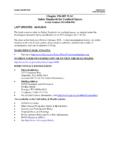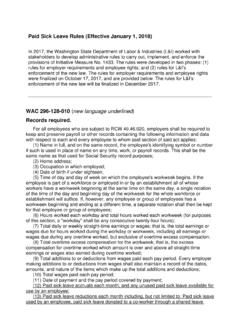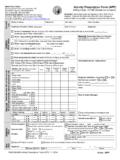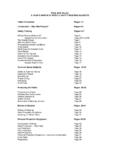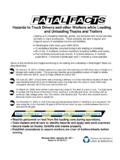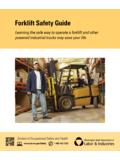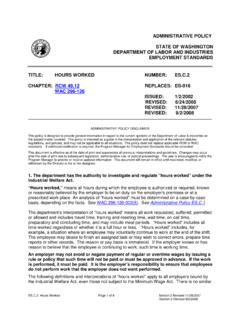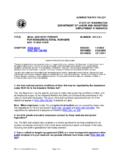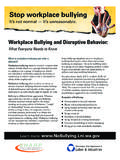Transcription of Confined Spaces, Chapter 296-809, WAC
1 Chapter 296-809 WAC Introduction Confined Spaces _____. Chapter 296-809 WAC. Safety Standards for Confined Spaces (Form Number F414-068-000). LAST UPDATED: 02/05/2018. This book contains rules for Safety Standards for Confined spaces, as adopted under the Washington Industrial Safety and Health Act of 1973 ( Chapter RCW). The rules in this book are effective February 2018. A brief promulgation history, set within brackets at the end of each section, gives statutory authority, administrative order of promulgation, and date of adoption of filing. TO RECEIVE E-MAIL UPDATES: Sign up at TO PRINT YOUR OWN PAPER COPY OR TO VIEW THE RULE ONLINE: DOSH CONTACT INFORMATION: Physical address: 7273 Linderson Way Tumwater, WA 98501-5414. (Located off I-5 Exit 101 south of Tumwater.). Mailing address: DOSH Standards and Information PO Box 44810.
2 Olympia, WA 98504-4810. Telephone: 1-800-423-7233. For all L&I Contact information, visit Also available on the L&I Safety & Health website: DOSH Core Rules Other General Workplace Safety & Health Rules Industry and Task-Specific Rules Proposed Rules and Hearings Newly Adopted Rules and New Rule Information DOSH Directives (DD's). See Chapter 296-809 WAC Table of Contents Confined Spaces _____. Chapter 296-809 WAC. Safety Standards for Confined Spaces WAC 296-809-099 Definitions.. 1. WAC 296-809-100 9. WAC 296-809-200 Identify and control entry into permit- required Confined spaces.. 11. WAC 296-809-20002 Identify permit-required Confined 11. WAC 296-809-20004 Inform employees and control entry to permit-required Confined spaces.. 12. WAC 296-809-20006 Follow these requirements when you contract with another employer to enter your Confined space .
3 13. WAC 296-809-300 Permit-required Confined space WAC 296-809-30002 Develop a written permit-required Confined space program.. 14. WAC 296-809-30004 Meet these additional requirements if your employees enter another employer's Confined space .. 16. WAC 296-809-400 Employee Training.. 17. WAC 296-809-40002 Provide employee training.. 17. WAC 296-809-40004 Certify employee proficiency.. 18. WAC 296-809-500 Permit-entry 19. WAC 296-809-50002 Implement procedures for safe entry into permit-required Confined 19. WAC 296-809-50004 Use an entry permit that contains all required information.. 20. WAC 296-809-50006 Keep and review your entry permits.. 21. Page i Chapter 296-809 WAC Table of Contents Confined Spaces _____. WAC 296-809-50008 Prevent unauthorized entry.. 22. WAC 296-809-50010 Provide, maintain, and use proper equipment.
4 22. WAC 296-809-50012 Evaluate and control hazards for safe entry.. 24. WAC 296-809-50014 Make sure you have adequate rescue and emergency services available.. 25. WAC 296-809-50016 Use nonentry rescue systems or methods whenever possible.. 26. WAC 296-809-50018 Make sure entry supervisors perform their responsibilities and duties.. 27. WAC 296-809-50020 Provide an attendant outside the permit-required Confined space .. 28. WAC 296-809-50022 Make sure entrants know the hazardous conditions and their duties.. 30. WAC 296-809-50024 Implement procedures for ending entry.. 30. WAC 296-809-600 Alternative methods .. 31. WAC 296-809-60002 Make sure the following conditions are met if using alternative methods.. 31. WAC 296-809-60004 Implement alternative methods for each permit-required Confined space that meet the criteria.
5 33. Page ii Chapter 296-809 WAC Confined Spaces _____. WAC 296-809-099 Definitions. Acceptable entry conditions. The conditions that must exist in a permit-required Confined space to allow safe entry and work. Alternative methods. Permit-required Confined space using alternative methods. An alternative process for entering a permit space under very specific conditions outlined in WAC. 296-809-60002 and 296-809-60004. The employer must complete documentation as required to communicate to the workers the space conditions. For an example, see Appendix J. Alternative Method Documentation by visiting the labor and industries web site at Atmospheric hazard. See definition of hazardous atmosphere. Atmospheric testing. See definition of monitoring or testing. Attendant. An individual stationed outside one or more permit-required Confined spaces to monitor the entrants.
6 Attendants must perform the duties required in WAC 296-809-50020. Barrier. A physical obstruction that blocks or limits access. Blanking or blinding. The absolute closure of a pipe, line, or duct by fastening a solid plate (such as a spectacle blind or a skillet blind) that completely covers the bore. It is capable of withstanding the maximum pressure of the pipe, line, or duct with no leakage beyond the plate. Calibration. Checking a direct reading instrument against an accurate standard such as a calibration gas to determine deviation and correct for analytical errors. Competent person. A person capable of identifying existing and predictable hazards in the surroundings or working conditions including those that are unsanitary, hazardous, or dangerous to employees, and has the authorization to take prompt corrective measures to eliminate them.
7 They must be knowledgeable in this Chapter . Confined space . A space that is all of the following: (a) Large enough and arranged so an employee could fully enter the space and work. (b) Has limited or restricted entry or exit. Examples of spaces with limited or restricted entry are tanks, vessels, silos, storage bins, hoppers, vaults, excavations, and pits. (c) Not primarily designed for continuous human occupancy. Note: See Appendix A Frequently Asked Questions and Examples for Confined Spaces by visiting the labor and industries web site at Control. The action taken to reduce the level of any hazard inside a Confined space using engineering methods (for example, ventilation), and then using these methods effectively to maintain the reduced hazard level. Control also refers to the engineering methods used for this purpose.
8 Personal protective equipment is not a control. Controlling contractor (employer). The employer that has overall responsibility for construction at the worksite. If the controlling contractor (employer) owns or manages the property, then it is both a controlling employer and a host employer. Page 1. Chapter 296-809 WAC Confined Spaces _____. Double block and bleed. The closure of a line, duct, or pipe by closing and locking or tagging 2 in-line valves and by opening and locking or tagging a drain or vent valve in the line between the 2 closed valves. See also Chapter 296-803 WAC, Lockout/tagout (control of hazardous energy) Early-warning system. The method used to alert authorized entrants and attendants that an engulfment hazard may be developing. Examples of early-warning systems include: Alarms activated by remote sensors; and lookouts with equipment for immediately communicating with the authorized entrants and attendants.
9 Emergency. Any occurrence (including any failure of hazard control or monitoring equipment) or event internal or external to the permit-required Confined space that could endanger authorized entrants. Energy-isolating device. A mechanical device that physically prevents transmitting or releasing energy. This includes, but is not limited to: Manually operated electrical circuit breakers. Disconnect switches. Manually operated switches that disconnect the conductors of a circuit from all ungrounded supply conductors if no pole of the switch can be operated independently. Line valves. Blocks. Similar devices. Note: Push button, selector switches and other control circuit-type devices are not energy isolating devices. Engulfment. The surrounding and effective capture of a person by a liquid or finely divided (flowable) solid substance that can be inhaled to cause death by filling or plugging the respiratory system or that can exert enough force on the body to cause death by strangulation, constriction, or crushing.
10 Enter (entry). The action where any part of a person's body breaks the plane (passes through an opening) into a Confined space . Entry occurs as soon as any part of the entrant's body breaks the plane of the opening into the space whether or not such action is intentional or any work activities are actually performed in the space . Note: When the opening is large enough for the worker to fully enter the space , a permit is required even for partial body entry. Permits are not required for partial body entry, where the opening is not large enough for full entry, although other rules such as Chapter 296-803 WAC, Lockout/tagout (control of hazardous energy), and Chapter 296-841. WAC, Airborne contaminants may apply. Entrant. An employee who is authorized by the employer to enter a permit-required Confined space .
